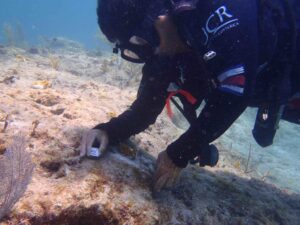Ambassadors of the Sea,
Cahuita, Costa Rica
On March 8, youth divers and activists will receive recognition for their leadership in the conservation of the ocean and its Caribbean culture, including the uncovering of secrets lying at the bottom of the sea in Cahuita National Park, Talamanca.
The ceremony will take place on the Rodrigo Facio campus of the University of Costa Rica.
Eight young activist divers of the Ambassadors of the Sea Community Diving Center (CCBEM) will receive a Leadership Award given by the University of Costa Rica (UCR) in recognition for their community leadership in the the most recent Expedition/Exploration/Exhibition Galleons and Other Vessels 2021-2024 Project organized by CCBEM, seeking the identity of the remains of two sunken ships.
Over the past eight years, several research expeditions have identified two shipwrecks that were Danish slave ships that arrived by nautical error in 1710 off the coast, carrying 650 enslaved Africans to be sold in the Americas. Expeditions have involved international and national scientists, along with the youth divers.
The young divers receiving the award for their leadership in this work are Pete Stephens Rodríguez Brown, Maraya Jiménez Taysigue, Salim Vásquez Rodríguez, Adir Garrido Morales, Aarón Mora Streber, Kevin Rodríguez Brown, Jimena Pechtel Gudiel and Matthieu Benneton. All are residents of the communities of Cahuita, Puerto Viejo and Manzanillo.
 Their community archaeological diving work has resulted in connecting a history hidden in national and international archives with their underwater archeological work to identify the shipwrecks at the bottom of the Caribbean seas.
Their community archaeological diving work has resulted in connecting a history hidden in national and international archives with their underwater archeological work to identify the shipwrecks at the bottom of the Caribbean seas.
Because the activity will take place on March 8th, International Women’s Day, it will also be important to recognize the outstanding leadership and work of women divers of CCBEM who played an active part in the research and expeditions. They have also contributed to development of paradigms of citizenship science with new methods of research that incorporate oral histories of area fishermen and other locals.

Additionally, representatives of the Leadership Program at UCR will present a Certificate of Recognition to the other 26 CCBEM divers who have participated in the expeditions and research. Support for the project involved permits from local authorities, in coordination with local co-governance of the Cahuita National Park, and the accompaniment of the University of Costa Rica’s Caribbean Campus.
Photo: Youth divers with Danish communicators (CCBEM)
The core intergenerational expedition group is comprised of 51% youth and 49% adults, of whom 25% are women and 75% men. About 25% come from Cahuita, 25% from Manzanillo, 40% from Puerto Viejo and 10% from other provinces or countries.
Among them, 55% are of African descent and mestizo identity, and 45% are Caucasian or of unknown mixed descent. Among them are Carlos Mairena, from a migrant fishing family in Cahuita; Antonio Mora with an eco-tourist initiative in Cahuita; as well as Kalil Salazar, grandson of the renowned Bribri social and cultural leader, and co-founder of the Talamanca Association of Ecology and Conservation (ATEC). Also involved in the project are Mauricio Salazar; Gloriana Brenes González, who was president of the CCBEM NGO during its first four years; and María Suárez Toro, co-founder of CCBEM and Coordinator if its Community Underwater Archeology Program and Research.
Program description and its contribution to history
Documents in the National Archive of Costa Rica and in Denmark refer to two Danish slave ships – The Fredericus IV and the Cristianus V – which on March 2, 1710 arrived by nautical error somewhere off the southern Caribbean coast of Costa Rica with 650 enslaved African women and men, to be sold in the Americas.
A mutiny on board the ships resulted in the release of most of the Africans on the shore, and then one ship was burned and the other was left adrift until it crashed into the reef.
After compiling the documentary information, previous underwater surveys and above all, collecting oral histories of the fishermen and the local population, the CCBEM divers organized a plan to discover the identity of the vessels and possible connections of all the data.
Since the ships’ arrival in the area over 200 years ago, the fishermen and families who established themselves in Cahuita told stories of two shipwrecks located in the waters off Cahuita in the PNC, providing important data, clues and narratives. Today it is the descendants of those fishermen and others who have organized an historical and cultural saga in citizen science to identify how the shipwrecks correspond to the historical archival data.
Determining the identity of the shipwrecks has been a slow and careful research process over the past eight years, with analysis of components of the ships’ structures. Very soon, perhaps even before March 8th, the final evidence of the identity of the ships will be scientifically confirmed when scientists in a research laboratory in Denmark’s National Museum provide results of the study of emblematic wood extracted with permits from the Brick Site in Cahuita National Park, alongside 20 more ballast bricks.
For more information write to: [email protected]



